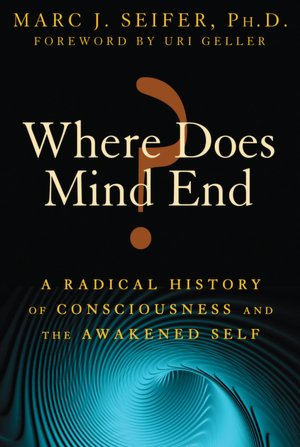
This is a re-write of a book originally published in 2003. Seifer begins with a hop-skip-jump through 3,000 years of thought about the human mind. Ancient philosophies are compared with Leibniz, John Stuart Mill, Henry Buckle, Karl Marx and Leo Tolstoy. Philosophy branches out to social theory and psychohistory. The brutal combat zone of academia is the sideshow: historians dislike psychohistorians, Freudians loathe behaviorists (while secretly allied to hypnotists, downwardly fraternizing like lonely old spinsters), scientists detest religion, various spiritual disciplines and occult sciences, and EVERYONE dogs parapsychology.
In the most interesting segment of the book, Freud’s model of the mind’s structure is supplemented by newer discoveries about the pre-conscious mind and the censor that prevents open access to the subconscious dungeon. Hypnotic states, sleep states and dreams are the means to identify how the pre-conscious censor functions. The physiological structure of the brain is also covered and lovely diagrams show the sectors brain and the roles they perform. There are numerous diagrams, tables, and some historic photographs interspersed with the text.
After discussing the break between Freud and Jung, the author moves on to Gurdjieff’s ideas about the will, which Seifer says fills in a gap in psychology. Whoops! What about the existential psychologists? Rollo May and Carl Rogers were both capable authors who wrote about the human will in an accessible, sensible way.* He also covers Gurdjieff’s ideas about the role of humanity in relation to God and planetary evolution. There are quotes from Dalai Lama about world peace, and quotes about obtaining happiness from infomercial guru Tony Robbins. Roberto Assagioli’s psychosynthesis techniques round out the book.
There are chapters about tarot and the structure of the Kabalistic Tree of Life, kundalini, the chi force, Wilhelm Reich’s orgone force, and even a nod at astrology. One must assume this is why the book is subtitle “a radical history,” as these are typically taboo subjects in academia. While touting the spoon-bending talents of Uri Geller, Seifer bemoans the lack of parapsychology testing that might verify some of the remarkable potentials of the human mind. There’s no mention of Abraham Maslow, a psychiatrist whose studies centered on extraordinary individuals and is perhaps most noted for his Hierarchy of Needs and self-actualization theories. A picture emerges from Seifer’s text, but he doesn’t quite reach the conclusion that while each generation of psychologists and psychiatrists add their own crumbs of truth to the overall picture of human behavior, none have managed to provide a complete picture that outlasts the next generation.
While the author is open-minded enough to consider metaphysical systems, his grasp of these areas are simplistic or garbled. The lengthy examination of these is pointless since Seifer writes about the “retrogression” of metaphysical thinking since the 1970s in the Epilogue. Given his spotty knowledge on metaphysical topics, it’s impossible to take his conclusions seriously. My personal favorite is the section where the author conflates the kundalini serpent with Lucifer and the id. Since Eve got an apple from a snake, the kundalini force and Lucifer must be the same thing (pg 136). Furthermore, Al Gore lost the 2000 election to George W. Bush because Clinton couldn’t keep his kundalini in his pants. It was difficult to keep track of all of the faulty syllogisms. I groaned in agony as Sir Bertrand Russell rolled in his grave.
What’s more bothersome is what’s omitted or ignored. The discussion of philosophy is cut off with Tolstoy. Nothing more recent is considered, which is too bad because 20th century philosophers have some good things to say. Existential philosophy/psychology and humanism are completely ignored, as is the shift to cognitive-behavioral therapy. The overview of psychology is myopic and piecemeal. The author fails to mention Isaac Asimov in relation to the development of psychohistory. The discussions of psychohistory verify why it’s one of the most abused and derided fields of study. The author’s whining about the herd mentality in academia gets old quick, although it is a relevant point.
The author hops through topics like a Mexican jumping bean and never settles into a discussion of the theme suggested by the book’s title. It’s more like a series of studies and essays than a book whose threads are eventually braided into a unified conclusion. This is a pity, because the title’s premise is worthy of deep exploration. On page 340, he finally mentions the thesis of the book, “where the individual mind ends.” He wrestles with the notion that there’s a divine component hidden within man, and feels that much might be explained if only scientists would actually study parapsychology.
While this book presents an unusual overview of philosophy, psychology, metaphysics, and neuroscience, the reader should be aware of the gaffes and omissions that make the book less than the title promises.
~review by Elizabeth Hazel
Author: By Marc J. Seifer, PhD
Park Street Press 2003, 2011.
Originally published in 2004 as “Inward Journey: From Freud to Gurdjieff.”
pp. 374, $18.95
*The existential psychiatrists: see Rollo May (1909-1994), “Love and Will,” “The Courage to Create,” “Freedom and Destiny,” and other books by this wonderful writer. These are quite accessible to the layman and chock full of brilliant thinking on existential questions of being human. See also Carl Rogers, “On Becoming a Person,” “A Way of Being,” and other books. See also: Irvin Yalom and Abraham Maslow.
